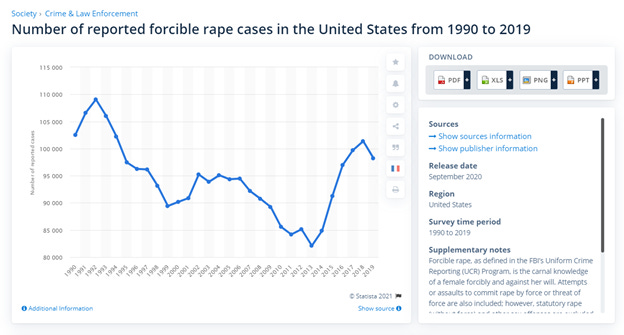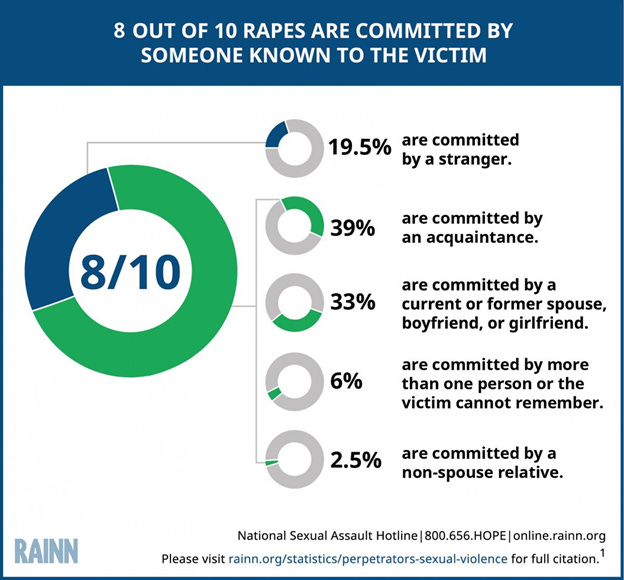This article is going to be short and sweet, and will stick to simple high school level probability concepts we’ve covered before regarding guns and revolutions and such, but instead we’re going to talk about rape. The math here will be applicable to the following culture war battleground topics:
“Talk to your daughters about rape,”
“Teach men not to rape,”
“Not all men are rapists,”
“She was asking for it,”
“Victim blaming”
…and all those other sorts of really awful, really garbage topics that cause people to rage against each other whenever this topic is brought up in social media.
I have a daughter, and I’m going to do this math problem with her when she gets old enough. But first, an anecdote.
Real Life Scenario
I know a lady. She’s cool. She does pole for fitness. She has a friend she met at a pole dancing studio. I’ve never met her friend. They went out for a ladies night this past weekend. They went to a pretty raucous bar which apparently had a pole at it. My friend generally behaved conservatively during the evening, although she got plenty of free drinks. My friend’s friend behaved in a much more outgoing manner, by which I mean she was dancing on the bar’s pole, getting men to throw her money, allowing them to grope her, and such. They were out until 3 AM, when my friend’s friend’s boyfriend picked them up safely. They had a good time. I’m glad the boyfriend picked them up.
And okay. This is a thing that free people should be allowed to do in a free society. But in a free society every behavior carries with it risk, and we can talk about risk without being accused of victim blaming, because risk is just math.
Risk Analysis
Let’s pretend for a moment that one out of every thousand men is a rapist. 99.9% of men aren’t rapists. I don’t know what the real number is, I’m just pulling a very small number out of a hat for the sake of discussion, and we will check the number below. If a woman goes to a bar, and bumps, grinds, and cavorts with 30 random men, then the chance that she bumps, grinds, and cavorts with that one rapist in a thousand is 1-(0.999)^30, or 2.96%. She has a 97.04% chance of avoiding the one rapist, which is pretty high, and potentially worth the risk.
If she does this same thing once per weekend for a year, her chances of bumping, grinding, and cavorting with that one rapist in a thousand is 1-(0.9704)^52, or 79%. Four out of five years of such weekly “cavorts” will include a cavort with a rapist. Even if the “rapist ratio” among men was exceedingly, outstandingly low, risky behavior adds up over time.
Real Rate
Is one rapist out of 1000 men low? High? The real number is very difficult to determine for many reasons, which go both directions. Most rape statistics are victimization statistics, so they track how many women have been raped, not how many rapists there are. If we presume one rapist will rape multiple women over the course of his life, as seems to be the narrative trend, a very small number of men could yield a significantly larger number of rapes. A lot of rape happens from an intimate partner or family member, not from cavorting at bars. And many of the organizations compiling rape statistics are incentivized to do things to inflate the numbers, such as changing the definitions behind the scenes of what they consider to be a rape, or sketchy statistics in general, particularly when it comes to measuring campus rape.
Let’s set all those arguments aside, which would take ten articles to sort, and presume that rape statistics by modern rape activism organizations such as the Rape, Abuse, and Incest National Network (RAINN) establish an upper bound. I like RAINN. I performed at a benefit show for them. Let’s use this graphic to back our way into the ratio of rapist men at cavorting, groping bars.
https://www.rainn.org/statistics/criminal-justice-system
We’ll add this graph from Statista:
https://www.statista.com/statistics/191137/reported-forcible-rape-cases-in-the-usa-since-1990/
In 2019, 98,213 cases were reported, with a 20 year low of 82,109 and a 20 year high of 109,060. Let’s further entirely ignore the question about how many of these were legitimate claims, and throw out the rest of the “led to conviction” data, because for this question of “cavorting at bars” we don’t actually care. In order to have a fun time at a bar, you want to leave the bar without feeling the need to report something, so the reporting number is actually a good gauge. Let’s throw 100,000 at this number, for a guestimate for any given year, based on the graph. By RAINN’s estimates, this would mean 434,786 incidents which could have been reported, and in their minds should have been reported.
But that’s total incidents, not incidents with women at bars. Per the FBI, 88% of rapes they have data on were forcible rapes by males in 2017, so let’s reduce the incident count to 385,150.
In our “cavorting in bars” scenario the potential perpetrators are strangers, so we further reduce the number to 75,104 because most rapes come from someone the victim knows.
Finally, we presume as has been reported in several places that the average number of rapes committed by a rapist is 6, so we arrive at a number of men who rape women in bars or similar environments of 12,517, annually. Industry analysts say 20.5 million people attend bars or nightclubs annually, somewhere around half of which are men, which yields a “bar rapist ratio” of 0.1221%.
Is that number right? No. The number is too high because a bunch of the 12,517 didn’t happen in bars. The number is too low because bars with cavorting loose women are going to be an attractor to that type of man. This too highness and too lowness is going to cancel out in some way that we can’t predict, but it seems as if my WAG (construction term: “wild ass guess”) of 1 out of 1000 men above is certainly in the ballpark for this specific scenario.
Takeaways
Can you “teach” these one out of a thousand men “not to rape?” Probably not. Should you “blame the victim” of a rape for being raped? It would certainly be terrible behavior to do so, and you are a bad person if you do that. Does “but not all men are rapists” really matter in this analysis? Not really, because one out of a thousand is enough.
Can you reduce your risk of rape by strangers by avoiding risky behavior? Absolutely yes. It’s right there in the math. And I’m going to explain that to my daughter when she’s old enough.






